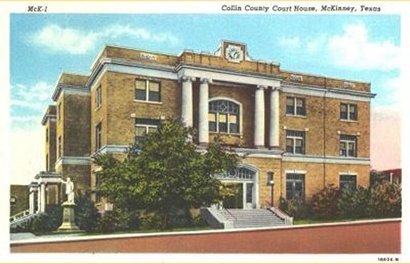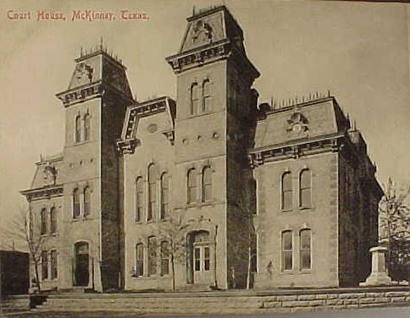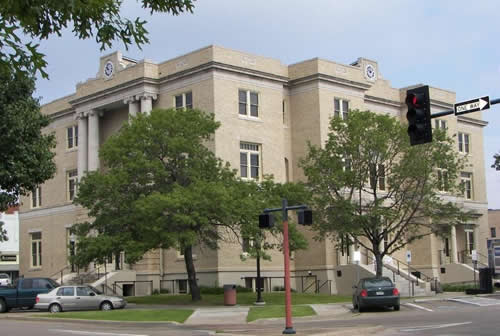|
Architecture
The Embodiment of Human Endeavor
by Guy R. Giersch
|
Stroll
down the east side of the square. Stop. View for a few minutes the
towers of the courthouse and you will wonder why they are allowed
to remain in their present unsightly condition. The panes in the windows
are broken out; the shutters are torn off and lie in the debris in
the attic, the rain blows in at the openings.
Bats in the belfry? No one can say, but it is known that hundreds
of English sparrows and pigeons find a roosting place in the towers.
If Collin County is not able to build a new Temple of Justice … then
we can at least put in some window-panes and patch up the holes.
On top of all that, the roof leaks, the floors are warped, and county
records are getting soaked. |
| You
would think you were reading a recent report but this came from the
May 5, 1921 edition of the Weekly Democrat-Gazette. The same
could have been said of conditions prior to the start of restoration
and rehabilitation of the Old
Collin County Courthouse. |
The 1874 Collin
County Courthouse as it appeared in 1908
Postcard courtesy www.rootsweb.com/ %7Etxpstcrd/ |
The 1874 Collin
County Courthouse after the 1927 remodeling
Photo
courtesy texasoldphotos.com |
| In
January 1928, County Judge A.M. Wolford gave the editor of the Weekly
Democrat-Gazette a tour of the newly remodeled courthouse. His
report dated January 12, 1928 follows: |
| This
imposing new Temple of Justice is now steadily nearing completion.
It is a decided improvement over the old structure in appearance since
the brickwork has been finished and the entrances are nearing completion.
The massive concrete columns at the north and south entrances and
the smaller ones to the eastern and western doors will add beauty
to the general architectural design of the whole building. |
| Later
that year on February 16, 1928, Reverend J.A. Old, pastor of the First
Methodist Church, told the editor of the Weekly Democrat-Gazette
his opinion of the newly remodeled building. |
I’ve
watched with a great deal of interest and appreciation the transformation
of the old courthouse, which had gotten to be a painful to the eye
and in very bad repair, into a thing pleasurable to the eyes, finely
arranged and splendidly substantial.
I am convinced that the building is substantial and well arranged,
as if a new building had been erected from the foundation, and in
the use of the old walls many thousands of dollars have been saved.
But the thing that is most notable to me is the beauty of the building.
I stood at the northeast corner of the square a few days ago and feasted
my eyes for a great while on the view that it offered me. There was
nothing to jar or grate on the aesthetic senses. Every feature being
worked out into fineness and fullest harmony. The color scheme, the
proportions and the expressions of substantialness, all harmonize
into superb beauty.
Justice should be pictured to us as something attractive and noble
by the building that houses it. And this has been admirably achieved
in the new courthouse. |
| Reverend Old
was aware of the way architecture embodies the ideals of the builders.
It is quite possible that Reverend Old had a classical education where
he learned of Jeffersonian ideals that made a connection between politics
and architecture. While Jefferson was in France he encountered the
Enlightenment philosophers’ admiration for the Roman Republic and
the notion that Roman architecture embodied the philosophy of the
Republic. After Jefferson viewed the Roman temple at Maison Carrée
he adopted the building style into the architectural forms used for
the University of Virginia. The ‘Age of Enlightenment’ promoted the
concept that humans have certain inalienable rights. Our Constitution
reflects the philosophies of the Enlightenment. In order to understand
the beauty of the 1927 Collin County Courthouse as compared to that
of the 1876 Collin County Courthouse we must understand the times
and the philosophy that shaped the minds that shaped the architecture.
|
 |
The 1927 remodeled
Collin County Courthouse,
Neoclassical Revival Style
Postcard courtesy www.rootsweb.com/ %7Etxpstcrd/ |
The
Old Collin County Courthouse is a three-story courthouse built in
the Neoclassical Revival Style. Neoclassical Revival architectural
movement is based on the use of Greek and Roman architectural forms.
Architects of the times were inspired by the World Columbian Exposition
in Chicago in 1893, which had a classical theme as well as the classically
inspired architecture of Andrea Palladio who inspired many of the
English and American architects of the 18th and 19th centuries. Neoclassical
architects of the early 20th century designed monumental classical
style buildings using giant pedimented porticoes, columns, and elaborate
cornices. It has been stated that no other style carries so well the
elements of dignity, simplicity and monumental repose essential for
public buildings.
The Courthouse is a rectangular plan built on a basement that serves
as a podium for the building. The band that runs around the building
just above the basement windows is called a water table and actually
servers a function of diverting water away from the foundation of
the building. The second noticeable band is called a stringcourse
and it separates the ground floor from the piano noble while the last
band on the building forms the entablature. The windows give an indication
of hierarchy with each set of windows changing on each of the three
floors in both size and treatment of trim.
As you approach the Courthouse you may at first be confused as to
which side is the front. Architectural hierarchy indicates that either
the north or south entrance should be the front since they are the
most heavily detailed of the sides. The east and west sides are scaled
down versions of the north and south facades with the same smaller
version of Ionic columns with a cornice and parapets with an oculus.
The oculi are the watchful eyes of the building and the top parapet
the oculi hold clocks, which give us the time of day but also count
down our time as we move through life. The very fact that you can
enter the courthouse from any side indicates the democratic ideal
of all sides are equal.
The north and south facades are dominated by larger stairs that lead
up to coupled, Ionic columns that are suspended on either side of
doors by piers, which join and form a segmental arch above the entrance.
The style is typical of the mannerist architects Palladio and Michelangelo
where the columns seem to carry an imaginary, heavy load that is not
there as well as being suspended above the ground in a manner, which
appears to defy gravity. The treatment is monumental and conveys the
very idea of the gravity and weight of the decisions within the ‘Temple
of Justice.’
Entasis is evident in these columns. Entasis is a slight convex curve
specifically used to create an optical illusion that makes the column
appear straight. Entasis creates the illusion of weight as well. The
columns form part of a trabeated system, which supports a simplified
entablature. The entablature is composed of an unornamented cornice,
frieze, and architrave. The scale of the columns and entablature lends
itself to the monumentality of the Old Court House.
The segmental arched pier that supports the columns uses a masonry
technique that simulates rustication, which emphasizes the joint and
creates a sense of a heavy mass to anchor the columns. The cast stone
elements that surround the doors have fasces. They symbolize the power
of life or death that a Roman Magistrate had over the Roman citizen
and a correlation could be made in terms of justice. |
 |
The 1874 Collin
County Courthouse
Second Empire style
Postcard circa 1908, courtesy THC |
The 1874-76/1927
Collin County Courthouse Cornerstone
Photo courtesy Terry Jeanson, June 2007 |
| It is possible
to argue the beauty of the 1876 Second Empire Courthouse is grander
than our Neo-classical version of the Court House that stands today.
However, when we arm ourselves with the understanding of the use of
the Classical idiom used to create the 1927 version we can then understand
the beauty, grace, and monumentality that was incorporated into the
‘Old Temple of Justice’ as it stands today. Our forefathers used the
classical idiom to capture the very essence of democracy and justice.
The same foresight from times past is being shown today by our Civic
Leaders. The decision to properly restore
the Old Court House and bring back to life a building that has
been the center of life in Collin County for over sixty years is as
forward thinking as that of our forefathers who saw the need to and
understood the importance of quality architecture for the citizens
of Collin County. |
 |
Copyright
Guy R. Giersch
Author's Note:
The Old
Collin County Courthouse is in the process of being restored and
rehabilitated into a community wide multi-use facility. The Courtroom
will have a restored
Wurlitzer Theatrical Organ installed by a group of theatrical
organ enthusiasts. I wrote this article some time past year since
many people always say why can’t we have the 1874 version instead
of the ugly 1927 version of the courthouse.
I really enjoy your site. Thanks for all your hard work to keep this
site up and running. - Guy R. Giersch, Historic Preservation Officer,
City of McKinney, TX, February 23, 2005
See Collin County
Courthouse |
|
|
